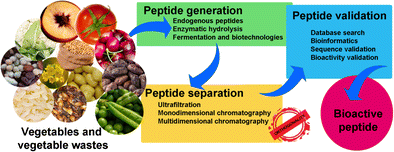Analytical and Bioanalytical Chemistry ( IF 4.3 ) Pub Date : 2018-01-20 , DOI: 10.1007/s00216-018-0852-x Susy Piovesana , Anna Laura Capriotti , Chiara Cavaliere , Giorgia La Barbera , Carmela Maria Montone , Riccardo Zenezini Chiozzi , Aldo Laganà
Interest in research into bioactive peptides (BPs) is growing because of their health-promoting ability. Several bioactivities have been ascribed to peptides, including antioxidant, antihypertensive and antimicrobial properties. As they can be produced from precursor proteins, the investigation of BPs in foods is becoming increasingly popular. For the same reason, production of BPs from by-products has also emerged as a possible means of reducing waste and recovering value-added compounds suitable for functional food production and supplements. Milk, meat and fish are the most investigated sources of BPs, but vegetable-derived peptides are also of interest. Vegetables are commonly consumed, and agro-industrial wastes constitute a cheap, large and lower environmental impact source of proteins. The use of advanced analytical techniques for separation and identification of peptides would greatly benefit the discovery of new BPs. In this context, this review provides an overview of the most recent applications in BP investigations for vegetable food and by-products. The most important issues regarding peptide isolation and separation, by single or multiple chromatographic techniques, are discussed. Additionally, problems connected with peptide identification in plants and non-model plants are discussed regarding the particular case of BP identification. Finally, the issue of peptide validation to confirm sequence and bioactivity is presented.

Graphical representation of the analytical workflow needed for investigation of bioactive peptides and applied to vegetables and vegetable wastes
Graphical Abstract
中文翻译:

由于其具有促进健康的能力,对生物活性肽(BPs)的研究兴趣正在增长。肽具有几种生物活性,包括抗氧化剂,抗高血压和抗微生物特性。由于它们可以由前体蛋白生产,因此对食品中BP的研究变得越来越普遍。出于同样的原因,由副产物生产BP也已成为减少浪费和回收适用于功能性食品生产和补品的增值化合物的可能手段。牛奶,肉和鱼是研究最多的BPs来源,但植物来源的多肽也很受关注。蔬菜通常是食用的,而农业工业废料构成了廉价,大且对环境影响较小的蛋白质来源。使用先进的分析技术分离和鉴定多肽将极大地帮助发现新的BP。在这种情况下,本综述概述了在BP研究中对蔬菜食品和副产品的最新应用。讨论了有关通过单色谱或多色谱技术进行肽分离和分离的最重要问题。另外,关于BP鉴定的特殊情况,讨论了与植物和非模型植物中的肽鉴定有关的问题。最后,提出了确认序列和生物活性的肽验证问题。这篇综述概述了在BP研究中对蔬菜食品和副产品的最新应用。讨论了有关通过单色谱或多色谱技术进行肽分离和分离的最重要问题。另外,关于BP鉴定的特殊情况,讨论了与植物和非模型植物中的肽鉴定有关的问题。最后,提出了确认序列和生物活性的肽验证问题。这篇综述概述了在BP研究中对蔬菜食品和副产品的最新应用。讨论了有关通过单色谱或多色谱技术进行肽分离和分离的最重要问题。另外,关于BP鉴定的特殊情况,讨论了与植物和非模型植物中的肽鉴定有关的问题。最后,提出了确认序列和生物活性的肽验证问题。

用于研究生物活性肽并应用于蔬菜和蔬菜废物的分析工作流程的图形表示
图形概要



























 京公网安备 11010802027423号
京公网安备 11010802027423号